Jambo!
Today was our second day in Kenya. After a delicious breakfast at Kolping Guest House we travelled to the University of Nairobi campus in the magic safari bus. On our way there we managed to see two giraffes on the side of the road. This mix of urbanization and wildlife is one of the things that makes Nairobi unique. In fact the Nairobi National Park is the only National Park in the world which is surrounded by a city. When we arrived at the University we were greeted by Shem a third-year student at UoN majoring in geography and tourism. With Shem we toured the geography and environmental studies building and had the opportunity to see a typical lecture hall (see cute photo below). We were then introduced to Dr. Francis Mwaura a geography professor and Dr. Boniface Wambua the chairman for the department of geography and environmental science. We were given a lecture by Francis on the biological history of Kenya. We learned many interesting facts about the country that we were not aware of before. Kenya has 5 distinct ecosystems (coastal, rift valley, lake, highland and lowland dryland). This Eastern African country is one of the world’s mega-biodiverse regions which contains 5 biodiversity hotspots. Kenya is home to 30,000 known species, dominated by plants and insects, and has a species density of 60-80 species/km^2. Francis also informed us of Kenya’s many endemic species one of which included the Sokoke Scops Owl. This species is a great example of the many conservation challenges in Kenya, as owls are seen as a bad omen among many tribes. Owls are thought to bring death to a community and some villagers may go as far as cutting down the trees they were perched upon in order to scare them away. This makes any effort to protect this species more difficult.
We also learned a lot about the dynamics of UoN. We were surprised that the school has three times more students than Queen’s, and an equal gender enrolment ratio. These facts were interesting to us as we had preconceived ideas of education being inaccessible in African countries especially to women. As we continue to see more of the country, and meet more Kenyan people, it becomes clear that many of the pernicious stereotypes the western world has about Eastern Africa are not always true.
After our informative meeting and some group pictures, we walked to the UofN Biology campus with Shem, Charles, Jerimiah, Andy, Moses and a few other local students. We got to go inside the department of Biology building where we met Odongo, who is in charge of all of the biology labs. We were able to visit two labs, including the animal physiology lab and an immunology lab. It was really neat to compare these to our labs back in Canada and realize how fortunate we are with our new technologies. We were also fortunate to meet with Robert Chira, the head of the Biology department, who explained to us his area of interest and his research on elephants. This was a really great experience to network and strengthen the bond between Kenya and Canada.
Next we embarked on a walking tour of downtown Nairobi, where we were able to browse the local shops, and take in the Kenyan culture. We noticed that there was a lot of city traffic on this mid-afternoon walk, but it didn’t detract from the beautiful views of the greenspaces, like City Park, which surround many of the major roads. Our tour then culminated with a visit to the statue of Kenya’s first president, Jomo Kenyatta, who coined the term “Harambee,” meaning “walk together,” which is very fitting of the friendly atmosphere we’ve experienced so far in Nairobi.
Our day ended with a bus ride, a beautiful rainbow, and as we are unable to entertain ourselves with wifi, some team bonding through wholesome conversation (ie. Is death by heat or cold worse? Why do all boys love Fast and Furious? Will there be showers at the campsite? Are we still going to the elephant orphanage??). Overall Day 2 was great and we can’t wait for tomorrow!
-The Room Geckos (Danya, Chloe and Hannah)
Click on photos to see larger images
- City Park in downtown Nairobi
- Shem, Danya and Zoe touring the UoN campus
- Beautiful rainbow as we drive through the congested streets of Nairobi
- Photo of a typical lecture hall at the University of Nairobi
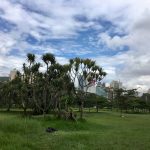
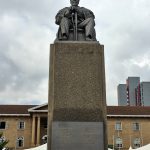
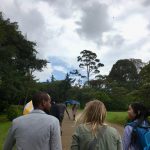
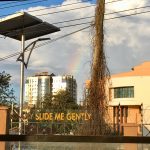
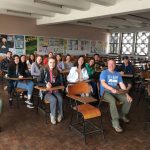
Leave a Reply